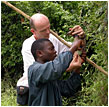|
WHERE ARE THE COASTAL FORESTS OF KENYA AND TANZANIA? AND WHY ARE THEY IMPORTANT?
Where are the coastal forests?
The Coastal Forests of East Africa are a chain of relict forest and thicket patches set within savannah woodlands, wetlands and agricultural land. The forests extend from Southern Somalia to Southern Mozambique and west to Malawi. They have been defined by WWF as the ‘Eastern Africa Coastal Forests Ecoregion’ and contain two WWF Global 200 ecoregions: the Northern and the Southern Zanzibar-Inhambane Coastal Forest Mosaics (www.worldwildlife.org/ecoregions).
The Coastal Forests in Kenya and Tanzania are a part of the Northern Zanzibar-Inhambane Coastal Forest Mosaic, which extends from the Kenya-Somali border to the Tanzania-Mozambique border along the coast. The ecoregion includes forest patches found on the islands of Zanzibar, Pemba and Mafia. These forests are characterized by a mosaic of vegetation types including evergreen forest, Brachystegia woodland, scrub forest and dry forest. They are typically found in small fragmented patches.
Mangrove forests are not considered to be Coastal Forest under this definition. Coastal forests are also distinct from the forests of the Eastern Arc in terms of climate, elevation and dominant plant species. Most coastal forests are found at elevations between 0 - 500 m up to a maximum of 1100 m depending on ecological conditions (Burgess et al. 2000).
Why are the coastal forests important?
The biodiversity of the coastal forests is recognised as being of global importance (WWF Global 200, 1998, and Conservation International Global Biodiversity Hotspots, 2004) due to the high levels of biodiversity and endemism found within the small, fragmented and highly threatened patches of forest.
The closed canopy coastal forests retain high numbers of endemic plant and animal species: 554 plant, five bird, three mammal, 24 reptile, five amphibian, 86 mollusc and 75 butterfly. The mosaic of habitats within the Hotspot, including forest, woodland and thicket, contain a greater total number of endemic species: 1750 plant, 11 bird, 11 mammal, 53 reptile, six amphibian and 32 freshwater fish. Of these, there are 333 globally threatened (Red list) species, with 105 species being represented in Kenya and 307 in Tanzania (IUCN 2002). It should be noted that reptiles and fish within the Hotspot are not currently on the IUCN Red list and once included these figures will increase.
In addition to the high biodiversity values of the coastal forests, they are also important because of their many and varied uses to people. Coastal forests are used as a source of medicinal plants, fuel wood, building materials, food and they help to maintain a regular water supply for towns and villages. They play an important role in reducing soil erosion, maintaining ecological cycles and micro-climates and carbon sequestration.
Many forests have an important cultural value to rural people, such that the forests and people are historically and spiritually bound. For instance the Kaya forests in Kwale and Kilifi Districts in Kenya are sacred to local communities with graves of important elders found within the forest. Sacred forests are also common in Tanzania and Mozambique, where extractive use is closely regulated by communities.
How much coastal forest is left?
Of the original 291 250 sq. km of the Coastal Forests of Eastern Africa Hotspot, only 10 % (29 125 sq. km) of natural vegetation remains. This is distributed across more than 400 forest fragments, most of which are less than 20 sq. km in size. Remaining pristine forest covers a total of 6 259 sq. km with the majority (4 778 sq. km) located in Mozambique; however, due to past civil strife in Mozambique these coastal forests are poorly known or researched and may reveal a wealth of biodiversity.
In Kenya and Tanzania, there are over 150 forest patches covering 1479 sq. km (CEPF 2005). While the highest levels of biodiversity are found in the closed canopy forest, this only makes up 2% of the total area of the Coastal Forest Mosaic (Clarke 2000; WWF-US 2003).
How well protected are the coastal forests?
Despite the obvious importance of the coastal forests in terms of biological value and the high levels of threat by deforestation, only 17% of the Coastal Forest Hotspot is formally protected with just 4% having high levels of protection under IUCN protected area categories I-IV. The two largest protected areas in Kenya are Arabuko-Sokoke (417 sq. km) and Shimba (63 sq. km). In Tanzania there are no protected areas over 40 sq. km; the largest reserves, Mitarure and Ruhoi are 60 sq. km and 68 sq. km respectively (Younge et al. 2002). Most important forest areas are found within government managed Forest Reserves.
|




